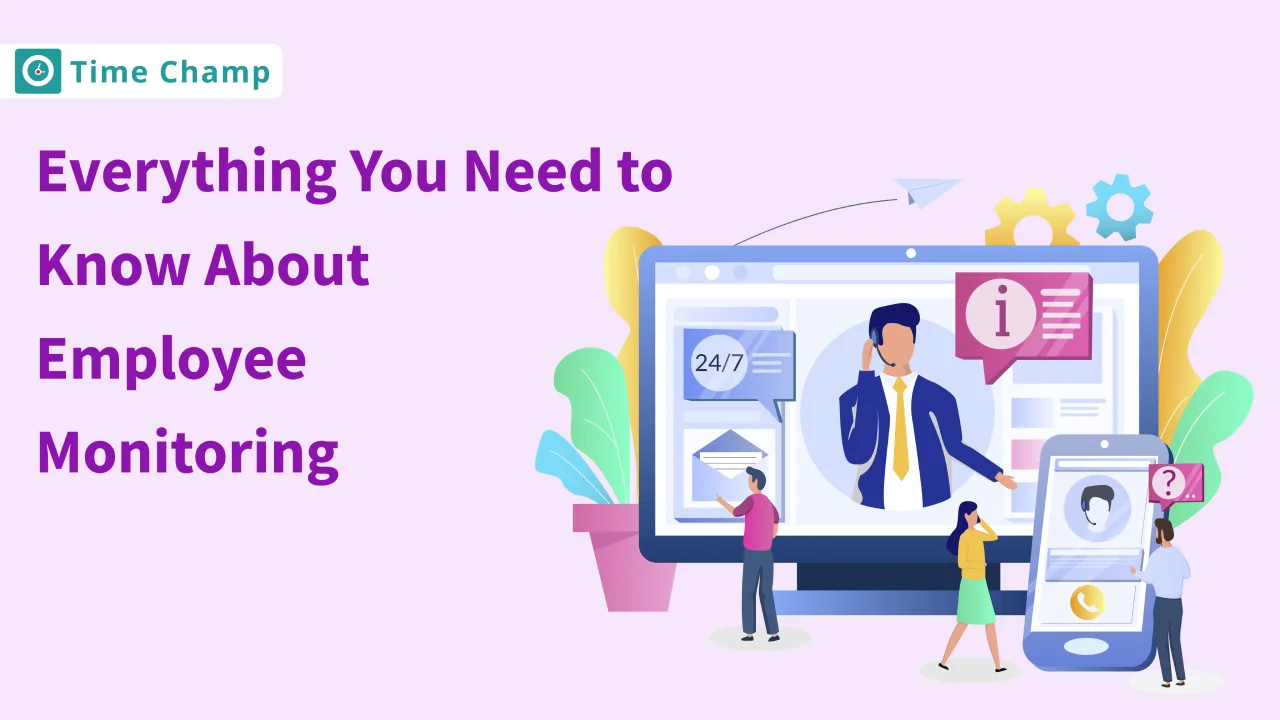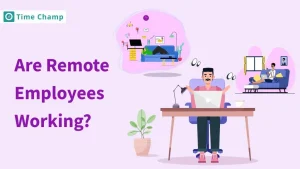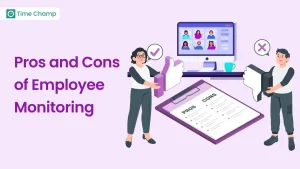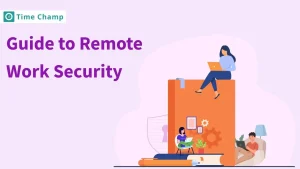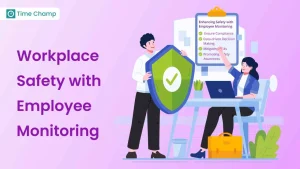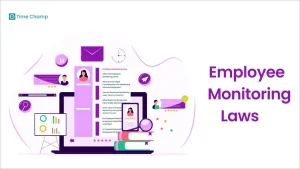Hey there! Let’s take a quick walk-through and find out what employee monitoring is all about if this has caught your attention. There is a need for the current business environment to take into account the need to be productive, as well as protect organizational information. With this in mind, Time Champ is your get-out-of-jail card. No, it is not only watching out for them at the back. Think of it as having your digital assistant on board for everybody to bring their game forward.
With employee monitoring software being necessary in modern workplaces. To ensure that people do not merely work but work well, there is a need to consider the fact that a greater number of individuals are calling from their homes or even drinking coffee as they meet these deadlines. Nowhere better is Time Champ needed because this tracking technology ensures your team has a workflow like silk, secure like a safe and transparent like crystal. The tool, known as Time Champ, plays the role of a guardian angel watching over your operations. It helps you track time and search out the inefficiencies within your business processes.
But wait, there’s more! Time Champ is not just a monitoring tool – it gives the team the freedom to be their own managers, to know themselves better, and to get a boost in productivity. When you combine such strong data with the necessary insight, you have everything needed by a great manager. It is all about that delicate relationship between supervision and independence. Time Champ is a great game to try out for you. See your team excel while your business prospers!
What is Employee Monitoring?
Whoa, hold up! First, let’s make clear what employee monitoring is. Picture yourself looking at things from above, as if you are a bird watching, as they happen in your company. Surveillance practice involves monitoring employees’ activities and performance using different techniques. It is not Big Brother’s game- it is about creating an open culture of safety and respect in the workplace that everyone understands.
On the other hand, monitoring employees can be done in various ways, such as observing progress on projects, stopping people who are divulging the secret recipe, and helping teams avoid online distractions. Being ahead of the business requires knowledge and technology. However, with an appropriate system installed, like Time Champ, you don’t only watch but rather steer your vessel to success.
And so, why bother to monitor, as you may ask, your child? It’s simple! It is not only about increasing productivity or protecting information but also about understanding how work takes place. Managers’ ability to build a dependable bridge with their teams. The legal issues are also not missing – monitoring helps to make sure that everything complies with the industry standards and norms. It’s a win-win situation in case done properly. Ready to get started? Why not let Time Champ lead the way?
Types of Employee Monitoring Software
There are many types of employee monitoring software, which are used to monitor different parameters of employee activity. These tools may vary from tracking time and screen activity to tracking communication, locations, files, and even keystrokes. Each one of them is for specific functions that ensure productivity, safety, and compliance.
Internet and App Usage Monitoring:
Starting with the internet and app using tracking services. Just imagine how many hours your team wastes on Facebook, Twitter, and other non-work-related websites during business hours! Using these technologies of employee monitoring you will be able to know everything. They watch over the URLs that are been accessed and the types of applications installed, therefore, you will be certain that your colleague is focused on the job in question or not in the new cat memes. Moreover, many of us admit that we really love the cat memes, but probably not the official working hours.
Screen Video and Capture:
Screen video and capture is not a movie studio, but it could turn out to be an even greater productivity blockbuster than it. This feature takes snapshots of screens of employees – you don’t even need to get off your seat. It means that you are looking at what they are and focusing on their work, avoiding any quick moves from the computer screen when you pass by them.
Time Tracking and File Tracking:
Okay tick tock let’s talk about time tracking and file tracking. Time is precious every moment at work – time is trackable with employees monitoring software for tasks and projects. File tracking also allows you to follow who has done what with company files, bringing another layer of responsibility and security. These two tools aid in the efficiency of workflow and boost production without infringing on one’s privacy.
Keystroke Logging:
Arriving fast with keystroke logging aka keylogging. This clever feature tracks every keystroke by your employees whether they do it intentionally or otherwise. In other words, it is all about appreciating the workflow patterns as well as spotting insecurity issues. As the law demands, there needs to be a balance between necessary security issues and individual rights while implementing this technique.
Location Monitoring:
Have a moving team? Location monitoring has you covered. It can help a company pinpoint the location of employees, especially those working with remote or traveling teams. It makes sure that every one of us is in the correct place and time, that is, no more, “I am around the corner,” when one still has not arrived home yet. Whilst it might increase productivity, security considerations and at the same time, employee’s concerns about privacy and ethics must be balanced to ensure that the use of IT is not abused.
Email, Phone, and Voicemail Monitoring:
Finally, monitoring emails, calls, and voicemails. This monitors all forms of communication and keeps an ear on the ground. This software facilitates communications through either, the email exchange with the client or the feedback from a supplier to conform with company policy and professionalism. To use these monitoring methods responsibly, it is imperative to strike the right balance between the need for oversight and the employees’ privacy.
Instant Messenger Monitoring:
Beware, instant messenger monitoring is after your buddy list. This follows up on every single message sent through instant messaging – thus, any secret talks become less secretive.
CCTV and Webcam Monitoring:
Webcam and CCTV monitoring can be viewed as your ‘digital eye’. Wrongdoing may be deterred and detected by it, but security should also protect the employees and the workplace so that the sole occasion for surprise in the office celebration will be the birthday cake. Therefore, an environment for mutual trust and support is needed. It’s about balancing security
Behavioral Monitoring:
Finally, behavioral monitoring. It is not about catching someone sneaking off in the morning; it is intended for understanding how the team functions, spotting any repeated moves in productivity, and smoothing the possible wrinkles in productivity. The team needs to function as smoothly as possible, for you to have all the parts inside out.
Greater Efficiency and Productivity:
Whoa! Speaking of the main advantage of monitoring employees, the sky-high efficiency and productivity come to one’s mind instantly. Imagine, your workforce has a private coach that makes the team constantly concentrate on goals.
First of all, such employees understand that they are being monitored and as a result, tend to adhere to their duties. When referring to such activities as excessive web surfing and friend chatting, they are time wasters that take much of the time away from us hence the name time killers. It is not to make everyone feel like Big Brother, but just a little hint for everyone to try.
Imagine for a minute you had data that told you when your team is high energy or when they are slackers. This intel is pure gold! This is the type of info managers can use to plan workflows, rearrange some tasks according to the level of energy, and even offer a timely pep talk or a break.
However, down to brass tacks. In most cases, software for monitoring comes with mind-blowing insights on analytics. Ponder upon it; patterns will appear in your work that were never there before. It could be that Tuesdays are terrible or the after lunch hours are slow like molasses. Armed with this knowledge, you can arrange work schedules, set reasonable targets, and also reward those who go the extra mile and deliver!
What is efficiency? Efficiency is about working smart, and it’s not all about hard work. The appropriate workforce monitoring software will enable you to automate tedious tasks such as recording time worked. It means that you would spend less time on admin and more quality time on your creative and strategic tasks. This would be like giving every person in the team a brand new, easy-to-use tool that makes their routine tasks so much simpler.
Sure, some fear the ‘snoopy eyes’, but smart business and wise teams recognize that monitoring software is a stepping stone to the top. That’s all about helping your team, tightening the engine for your operations, and cruising up to those.
Useful Employee Insights:
Picture this: Being a team leader, one of your week’s tasks is to know how your team is doing, in which area lies excellence, and where betterment is required. Whereas crystal ball is not available you turn to the next best thing employee monitoring software. However, it is not only that one should watch the times when they clock in and out of work. This is about getting gold value from their insights.
With a simple little device known as an employee monitoring system, you access the ocean of data. For example, is the person who logs in very early in the morning before daybreak? Is it the person with the weirdest search terms, or maybe the individual with the most innovative ideas? These may seem like trivial facts, but collectively, they give a picture of how your team works.
You might also notice that some jobs consume more time as compared to projected, necessitating more training and resources. You may see that great wizard worker or zipping through jobs like hot piece through butter – for future consideration for a management position. This is information that results in the better arrangement of the teams, refining of processes, and just making living easy for everybody.
However, one should never forget that great power comes with great responsibility. These findings should be utilized to raise up and not kill through managing into obliteration. So, use those insights wisely!
Security:
Let’s turn into another serious matter and discuss how it can be chilling even for adults if handled incorrectly—security. This is about this digital age where data is more precious than anything else, and tracking down confidential material is imperative. Enter stage left: employee monitoring systems that are not only watching productivity but also acting as guardians of the data world.
They’re not called busybodies; they are out there defending companies’ trade secrets and other important confidential information from cunning competitors. It is all about ensuring that Bob from the accounts department is not downloading stuff he should not, thereby creating room for possible breaches. Or that one doesn’t write or pass the company’s secret information to people in a social chat, using work mail.
Amid this search for security, however, it is incumbent upon us not to throw away the respect for privacy. The best monitoring software takes security to the point of securing against external threats but not to a level where your workplace transforms into a dystopic big brother. In this manner, employees are confident their employer values a contribution but also respects an individual’s privacy.
Therefore, while traversing this new world of work let us bear in mind that an executed employee monitoring system is an umbrella that shields the company’s property and its employees’ trust. Indeed, a protected company is a powerfully established company.
Cons to Employees and Employers Instruction:
Employee monitoring can also have some benefits but it is not perfect. Tangibly for employers, surveillance could be invasive of employees’ privacy and autonomy is a very unsettling concern. It feels like a constant person is standing behind them to watch their back – not always the easiest to deal with. This may cause staff not to have enough trust to openly communicate with the management.
The cons don’t spare employers too. They may have to handle huge amounts of data that are of no essence or relevance to the performance metrics. Walking this tightrope between necessary oversight and data overkill is essential. Otherwise, management could be throwing away money they should be focusing on data that benefits their company.
Besides, such systems are expensive to implement and maintain too. In some instances, smaller businesses may find it difficult to justify such investment due to marginal improvement in productivity and security. Furthermore, such scrutiny could also damage the company culture and affect team unity among employees.
Disadvantages for Employees and Employers.
However, there are some cons associated with employee monitoring. From an employee’s perspective, tangible concern about how surveillance could infringe upon their rights and freedoms could result in very uneasy feelings. It’s like one is always looking through their shoulders, which certainly may not be a pleasant sensation. The result might be distrust among staff and management, making them reluctant to be transparent while communicating at their place of work.
The cons are not spared by employers. This could mean having to deal with excessive numbers of data that are neither essential nor pertinent to the scorecard measures. However, useful oversight can help avoid wasting precious resources. However, the line between beneficial oversight and data overload is thin, and if crossed, the company will end up using funds on irrelevant data.
Additionally, the cost needed for setting up and keeping such systems is no mean price. For instance, smaller businesses may find it difficult to justify such an initial investment, when compared to real gains in productivity and security. In addition, employees should never feel as if they are being unfairly watched, lest company culture suffer and teams become less cooperative.
Additional stress is associated with lower morale.
Picture yourself being under scrutiny knowing that every step you take is analyzed (how about this for stress). Some employees may feel like this when subjected to continuous surveillance. The continuous pressure of observation may aggravate the stress level, which would impact negatively job performance and satisfaction. Come to think of it, most of us would agree that a frustrated worker is hardly at his or her highest productivity.
Secondly, knowing that one is being watched, may discourage creativity. If employees are apprehensive, they may be unlikely to risk or try something new. This is the “playing it safe” mentality, and that’s not a breeding ground for original concepts.
Morale is another reason for worry. However, when staff members do not feel that they are trusted or appreciated for more than just their production, it can diminish their connection to their work—and their company. Such separation will lead down the slippery path to decreased commitment, poor performance, and even higher attrition rates. Hence, even though monitoring seeks to enhance performance, if not appropriately applied, it could potentially be its antithesis.
Can employers legally monitor employees?
Ah, the million-dollar question: Can you monitor your employees legally? Alright, let us get to this vital matter. Therefore, there is a need for the company to uphold the rights of its employees while maintaining the confidentiality of the company’s interests. Hence, where does the law stop?
Folks, it depends on the location. However, from a bird’s eye view, most countries allow monitoring of employees though not excessively particularly for utilization of company facilities/devices and while one is at work. However, transparency is key! Monitoring policies should be communicated to employees. So to speak, as if saying, “We are watching what is going on here,” except for a professional policy-document style.
Some forms of monitoring are acceptable if done the right way, such as monitoring emails and internet usage through company devices. However, that is as big as an invasion of privacy is a major no-no. For example, you cannot search other people’s private devices during non-working hours or outside the workplace without overstepping your boundaries and violating the law. For this reason, it is always recommendable to seek legal counsel that is specific to your locality before going about setting up any kind of monitoring system.
Strict stipulations are there in data protection laws like the GDPR in Europe on employee monitoring. Firstly, it is important to have a defined aim for your survey. Secondly, inform employees that all the data is for an internal investigation. Thirdly, make sure your data remains secure, and finally, don’t request information that you don’t actually require. A legal tightrope. Be careful while walking it!
Bottom line: It is legal to monitor – as long as it’s all-encompassed with caution, consent, and staying within bounds. Therefore, do not break the law, do not be unethical and when you are unsure, consult a lawyer. This is where they have their forte because they are adept in such legal mazes.
Choosing an Employee Monitoring System.
Choose the best employee monitoring system when choosing among several options available for your company. To ensure you’re making the best decision, focus on the following aspects:
Customization: The tool must be customized to suit your business requirements with a personal touch on every team’s needs.
Integration: Choose software that integrates well with other programs, so as to keep your workflow intact and limit hindrances.
User-Friendly Interface: The learning curve should be lowered through a choice of a friendly interface. User compliance is also increased through the same.
Data Security: Provide adequate security features for a monitoring solution so as to guarantee the confidentiality of sensitive data.
Compliance Features: In addition, the system should enforce compliance with legal provisions and privacy laws.
Reporting Capabilities: They should have effective reporting tools, which produce useful actionable insights while generating detailed analysis of productivity.
Ensure that you consider the trial versions to ascertain if the proposed information system is compatible with your organization before commitment. It is advisable to start with a pilot or trial approach to enable you to assess its usefulness and acceptability by your workforce.
Conclusion
Businesses that are keen on improving productivity and ensuring that security measures are tight will find employee monitoring systems indispensable. If you want more than simply just time running, you should employ an effective tool such as Time Champ so that the movement of your group is in line with company objectives.
The Monitored Features of Time Champ helps to understand the productivity patterns of the employees at any point in time. All in all, TimeChamp is a comprehensive set of solutions created to improve your team’s performance and ensure the reliability of your company’s sensitive information.
Time Champ ensures that every single member of the team remains accountable and aligned whether they are in the same office or on another continent. So, why wait? Visit Time Champ now and increase the efficacy of your teamwork and transparent business processes. Dive into detail and make use of accurate tracking with Time Champ—every second matters!
Signs your work computer might be monitored include the presence of monitoring software like Time Champ, unusual network activity, and company policies that outline monitoring practices. Always check with IT policies to understand your company’s stance on monitoring.
Employers can use employee tracking technology like Time Champ’s software to monitor remote workers. This software can track time spent on tasks, screen activity, app usage, and provides productivity analytics.
Research is key in finding the right employee monitoring software. Look for workplace tracking software with features that match your company’s needs, such as Time Champ, which offers comprehensive monitoring solutions.
Employee monitoring software, like Time Champ, works by tracking and recording various employee activities on their computers, including application usage, internet activity, and time management, while ensuring security and productivity.
Tracking employees can be done through teams’ employee monitoring tools, which can capture time spent on projects, attendance, and other work-related metrics to evaluate performance and productivity.
Companies monitor employees by implementing a monitoring system that could include software to track internet and app usage, screen recording, key logging, location tracking, and more, to ensure efficiency and security in the workplace.
Yes, employee monitoring software like Time Champ can be highly beneficial for managing remote teams by offering insights into employee productivity, ensuring timely task completion, and providing data for better management decisions.
Legal considerations include understanding privacy laws, having clear company policies on monitoring, obtaining consent from employees, and ensuring that monitoring practices are compliant with legislation like the GDPR or other local laws.
Definitely! Employee monitoring software typically includes tools that help in tracking the time employees spend on specific projects, thus providing employers with valuable insights into project progress and resource allocation.
It’s crucial to balance monitoring with respect for employee privacy, to be transparent about monitoring practices, and to use the collected data responsibly to maintain trust and morale within the team.
